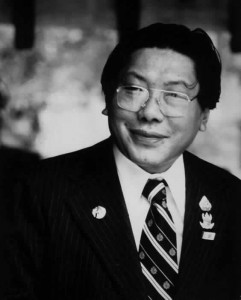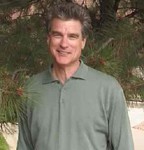Monday
VCTR TributesTurn it Yourself
 A Recollection of Chogyam Trungpa Rinpoche
A Recollection of Chogyam Trungpa Rinpoche
by Frank Berliner
edited from a Chronicles interview on 18 March 2002
My first recollection of the Vidyadhara, Chogyam Trungpa Rinpoche was when he gave meditation instruction to all the new students at the first session of Naropa in 1974. I remember sitting in a large auditorium with hundreds of other people waiting for him. When he finally arrived, it took a few moments for my mind to catch up with its expectations and realize that the little man in the dark suit, walking with a pronounced limp was, in fact, Chogyam Trungpa.
I remember that he smiled a lot and joked a lot and in particular I remember that, after he gave meditation instruction, a student raised his hand and said: “Rinpoche, why the outbreath? Why not the inbreath?” And my recollection of what he said (and of course I’m paraphrasing here) was:
Well, it’s like this. When you come home at the end of a long day and you’re really stressed out and tired, you go into the kitchen, you open the refrigerator, you take out a beer, you open the beer, you go into the TV room, you turn the TV on, you sit down on the couch. You don’t go (loud sound of sudden inbreath).
After that I never had any misunderstanding about why it was the outbreath.
At the end of that summer, I resolved to be his student and I ended up moving to Tail of the Tiger, which actually that very year had been renamed Karme Choling by His Holiness Karmapa during his first visit to the United States.
Soon after I arrived at Karme Choling, I met the Vidyadhara for the first time. I was in a receiving line waiting to meet him, and while I was waiting I had all these thoughts in my mind about what I might say to him. By the time it was my turn, my mind was going like crazy. I shook his hand and before I could utter a word, he looked at me and said, “Don’t try too hard.” And that was it.
Follow your Coincidences
I applied to the 1975 Seminary and, because I thought of myself as a good student and a smart person and somebody who learned quickly, I thought I should be accepted. So I had an interview with Rinpoche and asked if I could go. He said, “I don’t think you’re quite ready.” I was very disappointed. It was the first time anybody had said “no” to me, and he said it with such assurance.
A year later, I asked again if I could go and again he said, “no.” I was finally accepted two years later for the 1978 Seminary. [ed: there was no Seminary in 1977.] But I was rejected twice, which was quite powerful for me. I was used to having doors open when I knocked.
In the short term, this now undermined my confidence. It threw me quite painfully back upon myself, and made me realize how arrogant and competitive I had become. In the longer term, it helped me understand that genuine confidence was based on something else altogether.
At the end of the 1978 Seminary, I had an interview with Rinpoche and asked, “What do you think I should do next?” and basically he said “How should I know?” But then he ventured to say that I should leave Karme Choling. So I asked again, “What do you think I should do?” And he said, “You should follow your coincidences.”
An hour later, I was having lunch with John Lewis, who was a fellow student at seminary and he said, “You know, my mother runs a modeling agency in Atlanta and you look a little like those guys on the billboards for the Winston ads. Maybe you should see if you can do that.” Anyway, one thing led to another and I ended up becoming a model.
A few years later, in 1982, I was living in Boulder and had already been modeling for a few years and was also the Director of Shambhala Training. I was feeling quite frazzled trying to relate to these two very different aspects of my life. I felt torn. I felt that by serving Rinpoche and teaching the dharma, I was doing this really exalted and spiritual thing, but that by being a model, I was doing this lowly and slightly perverted thing. So I had an interview with him and expressed my confusion.
I said, “What do you think I should do about this problem with the modeling?” hoping that he would say something like, “Yeah, I think you should quit and maybe we’ll figure out a way to pay you more at Shambhala Training . . . ” you know, wishful thinking.
But instead he said, “Do it more!”
So I did. I did it more. A year later I was asked to go to Berkeley to be the Ambassador and, since my parsonage was very small, I continued modeling for a number of years to supplement my income until, eventually, my career as a model ran its course and ended quite naturally.
Looking back on it now, I think that modeling helped me see that my ideas about what was and what wasn’t a respectable thing to do with one’s life were purely my ideas. In telling me to do it more, I feel that Rinpoche was inviting me to play, to have more humor about the world.
In my experience, he approached every aspect of his life with a quality of total exertion and, at the same time, enormous playfulness. Often, when he taught about exertion, he would say: that you need to be like an elephant. You need to walk steadily, one foot after the other. But you also have to look around and when you look around there’s a sense of humor. There is room to be playful and to pick up on little coincidences that are happening all the time.
To be able to do both — to be focused and spacious at the same time — is very powerful. He exemplified that more than anyone.
I Respectfully Request . . .
The Vidyadhara taught a Level V the first year that I was in my post in Boulder. It was one of the early Level Vs and there were a huge number of participants, mostly from the Buddhist community, but there were a lot of new people there as well. For the Friday night talk, he arrived in his military uniform, which at the time was shocking to just about everybody. As the Director of Shambhala Training, I was given the task of introducing him.
I got up in front of the full shrine room under his watchful gaze. I was slightly freaked out that he was in uniform and I found myself giving a really long and flowery and somewhat overdone introduction about who he was. Every once in a while, I glanced up at him and he looked thoroughly bored with what I was saying, like he was about to fall asleep.
Finally I got to the end of my introduction and I turned towards him and said, “Sir, on behalf of all the student warriors assembled here, I respectfully request you to turn the wheel of the Shambhala dharma.”
As if opening his eyes from a nap, he looked at me and said, “Turn it yourself.”
Read the rest of this recollection on The Chronicles of Chogyam Trungpa Rinpoche by clicking here.
~~
 Frank Berliner became a student of the Vidyadhara during the first summer of the Naropa Institute in 1974. He lived at Karme Choling from 1974-78, then served Trungpa Rinpoche over the next fourteen years as National Director of Shambhala Training and Ambassador to the Berkeley Dharmadhatu. Frank now lives with his wife Nan in Boulder, Colorado, where he teaches the psychology of Buddhist meditation at Naropa University, and maintains a private practice as a psychotherapist and organizational consultant.
Frank Berliner became a student of the Vidyadhara during the first summer of the Naropa Institute in 1974. He lived at Karme Choling from 1974-78, then served Trungpa Rinpoche over the next fourteen years as National Director of Shambhala Training and Ambassador to the Berkeley Dharmadhatu. Frank now lives with his wife Nan in Boulder, Colorado, where he teaches the psychology of Buddhist meditation at Naropa University, and maintains a private practice as a psychotherapist and organizational consultant.



Aug 17, 2015
Reply
I remember those days in Boulder at Shambhala Training! Adana was the director then Frank. I took Shambhala I three times. Frank said I had to move on, so I did. I was attended that particular Level 5, too! Thanks for the memories Frank.
Aug 14, 2015
Reply
Frank, thanks for this offering. I so enjoyed your personal account of beiing a student of the Dorje Dradul! It’s very timely because I was just sharing the following with Phoenix Shambhala friends who had Adana Barbieri in town directing a Level I. Adana had came to Vancouver about Jan. 1980 (?) to offer that Center’s first ever Level I where I was a very new student. (I had sat already for three years on my own after reading Zen Mind Beginner’s Mind but when I walked in the door in Vancouver, it was the first time I ever sat a whole hour!) Anyway, we were all being encouraged to take this Level I, so I cautiously came out to here Adana’s free, Fri. night talk. I found the message totally un-riveting and her attire (grey pleated skirt, blue blazer, fluffy red & blue neck scarf,) completely off-putting. I was an artist at the time, a painter, and definitely into casual. Could not relate with this corporate look!)
Vancouver wanted to offer a second Level 1 six months later before they held a Level II,) so I decided to wait and see if that Director was less of a robot (sorry, Adana!) But, no, low and behold, it was an even further vision of perfection, Frank Berliner dressed in grey slacks, a blue blazer and requisite red and blue corporate-type necktie – in reality, truly a male model from some realm I had no connection with!!! (Somehow, I couldn’t imagine ever measuring up to such an image!) Well, I mulled it over, decided this was how the message was being packaged and there must be no other choice. So I took the Level! None of the talks made any sense to me, but the sitting was good. AD Dennis Morbin did my interviews. I found him sympathetic and easy to relate with, so I got through the weekend. Anyway, thanks for taking on the challenge of presenting Shambhala Training in Vancouver during that era. I’m truly grateful after 37 years you were part of my evolutionary development on this wonderful Shambhala path, in fact, pretty much part of my first step! Much appreciation!
Aug 11, 2015
Reply
Thank you for sharing/writing this! Quite an interesting bit teaching from VCTR.